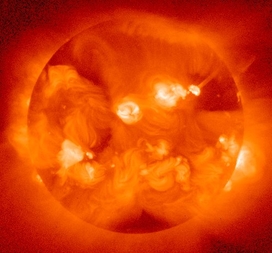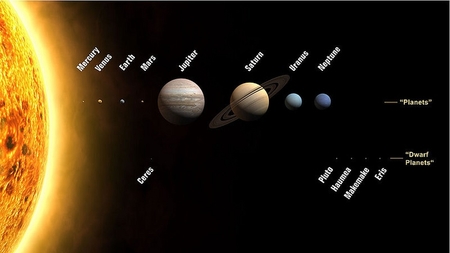 |
 |
 |
 |
 |
 |
 |
 |
|
 |
 |
 |
54 Formation of stars
|
| Menu | back |
The origin of the stars is the heart of cosmology. Stars are the source of solar energy and, according to the big bang theory, the only sources in which the heavy elements in the universe (metals) could have been formed. However, in spite of continuing affirmations from many cosmologists, the origin of the stars is still unsolved.
|
 |
|
 |
| The Sun |
|
Solar System |
Stars are glowing balls consisting primarily of hydrogen held together by their own gravitational force. Allegedly, they developed because of minor irregularities in the expanding hydrogen following the big bang. The problem is that any accumulation of gases will increase their temperature. Heat causes increased internal pressure, and this will stop further accumulation.
After the accumulation of the gas has come to a standstill, it would have to cool down. Accumulation could continue only after the hydrogen would have cooled down. However, one single cooling phase would require up to forty billion years, while the universe is allegedly only fifteen to twenty billion years old.
Exceptions:
In gas clouds, up to approximately ten times heavier than the sun, the development could progress at a much higher rate. Since its gravitational force would be considerably higher, the high temperatures would develop much more quickly. After only one million years, they would have used up the hydrogen and become red giants. After all further possible nuclear reactions have taken place, a gigantic explosion would occur resulting in a supernova. The external part of the star would have been blown out into space and the inner part would become a neutron star (1).
If the gas cloud were heavier than ten times the sun, the red giant phase could have been reached after approximately one million years, resulting in an even greater catastrophe: When the core collapses, the field of gravity would become so large that even the neutrons in the individual atoms would collapse. It is assumed that the star would then become a so-called black hole 2..
These 55 | Menu |
back
|
References:
|
| (1) |
Alex Williams, John Hartnett, Dismantling the Big Bang, Master Books, 2006, pages 140142. |
| (2) |
A.K. Kembhavi und J.V. Narlikar, Quasars and active Galactic Nuclei, Cambridge NY: Cambridge University Press, 1999, pages 101103. | |
| |
(Image "The Sun") http://en.wikipedia.org/wiki/Sun
(Image "Solar System") http://en.wikipedia.org/wiki/Solar_System |
| |
Comment this Site!
|
 |
 |
 |
 |
|

